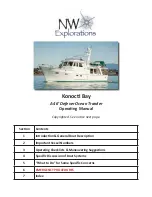
16
ELECTRONICS
The Furuno TZ 15 chart plotter is the main source of information. It has its own GPS
receiver and is connected to the Radio. The independent GPS and the older Radar 2
are connected. They derive their location information from the older GPS reciever.
The VHF radio has an emergency button. But it needs the location from the GPS to
transmit this information. So, you need to turn on the chart plotter and the radio.
The radio will show the position and time. The instruments switch operates the fuel
and water gauges. Be sure to cross reference the tanks valves in the engine room
and gauges. It is not automatic.
A GPS is located in the pilothouse. Turn on by pressing the power button. Turn off
by pressing and holding the power button until it goes off.
The primary radar is available on the navigation set. This is not radar 2. Click the TX
button on the lower left to start or stop the radar display. Give it a few seconds and
it will overlay the chart. To operate the secondary radar press and hold the power
button. To turn off, hold the power button for about 3 seconds. Remember you are
not allowed to travel in fog or at night.
There is a DSC enabled VHF radio located in the pilothouse. Make sure the breaker
is on at the DC Panel. Always monitor Channel 16 while underway. Also verify that it
displays the lat/long. If it does not it will not transmit your position in an
emergency. The radio transmits information to the AIS system. All commercial craft
can identify the Mary K and you can identify them by clicking their identification on
the chart plotter/
There is a depth sounder located in the pilothouse which is independent from the
chart plotter depth indication. There is a difference in the readings because the
chart plotter adjusts for the depth of the keel to the transducer difference. To
activate, ensure that the DC breaker is on. Turn on the depth sounder with the
knob
.
Note the sounder has an alarm for depth which can be set to several depths.
Also note it can be set for feet or fathoms. The sounder is reliable in waters less
then 200 feet and at the slower speeds of the Mary K. If your reading is blinking, it
might be a false reading due to excessive depths or strong currents! Watch your
depth carefully in cruising unknown waters that might have rocks or obstacles.
The secondary Furuno radar includes a Chart Plotter. Use the menu button to scroll
the options.
The auto pilot is powered up by the switch on the DC panel. Once powered and in
the standby mode, the dodge buttons can be used to move the rudder. You will find
this is the fastest way to move to the rudder. However, you must keep an eye on
the rudder position or you will find that you overcontrol. Once underway press the
run button to hold the present heading. This unit will not track a course nor correct
for drift.



































